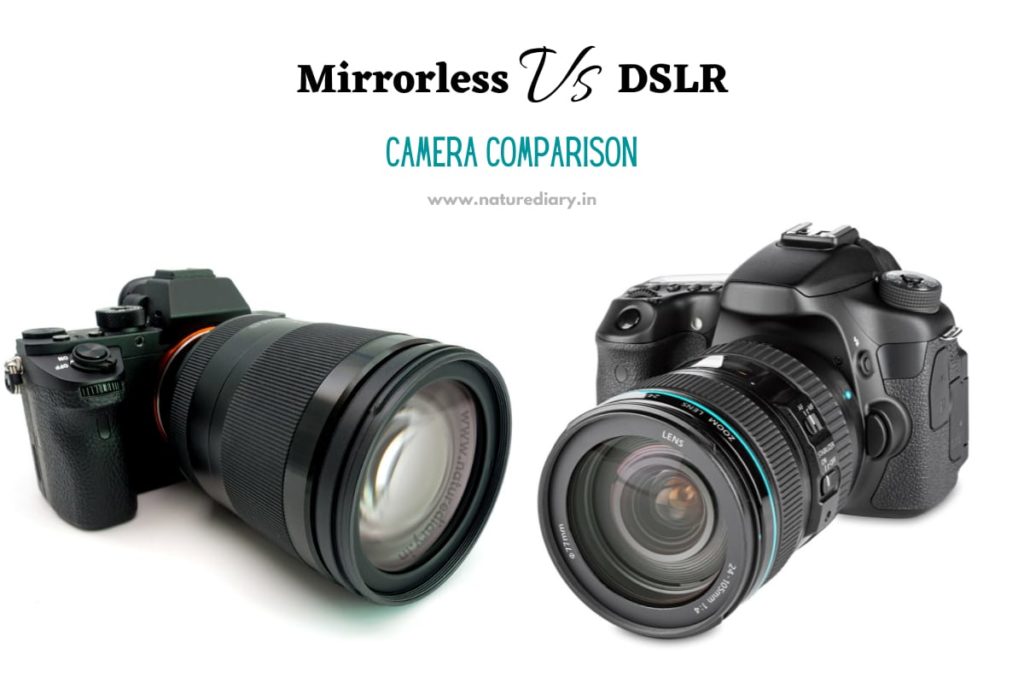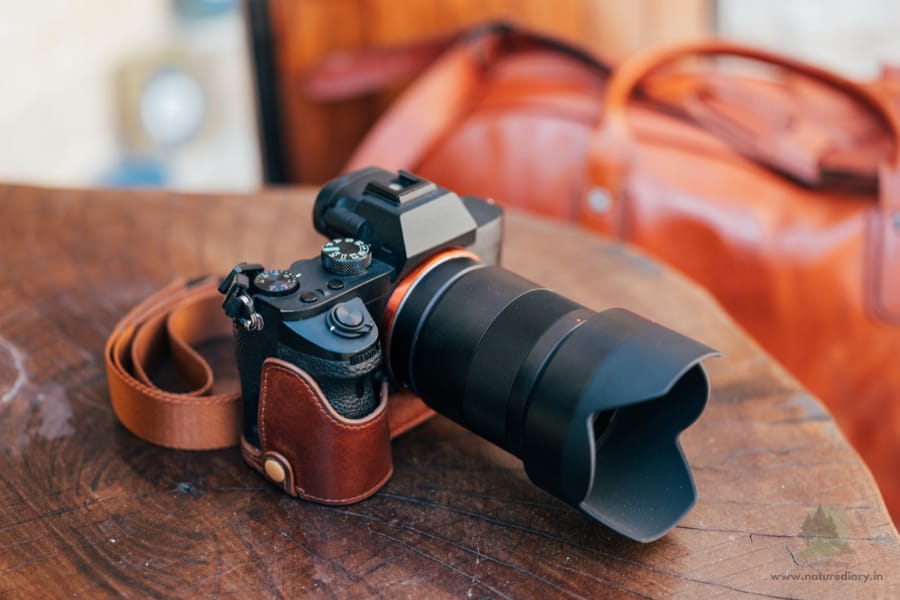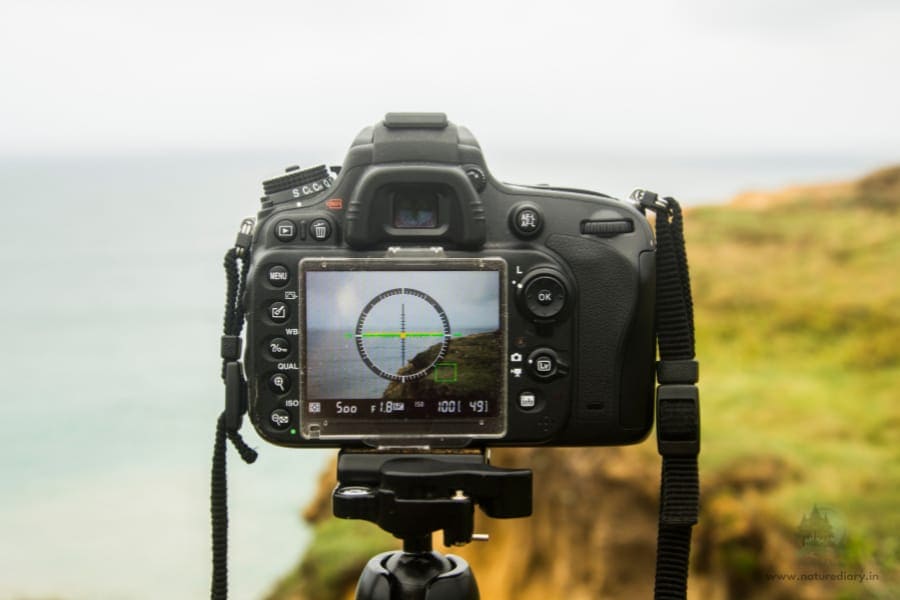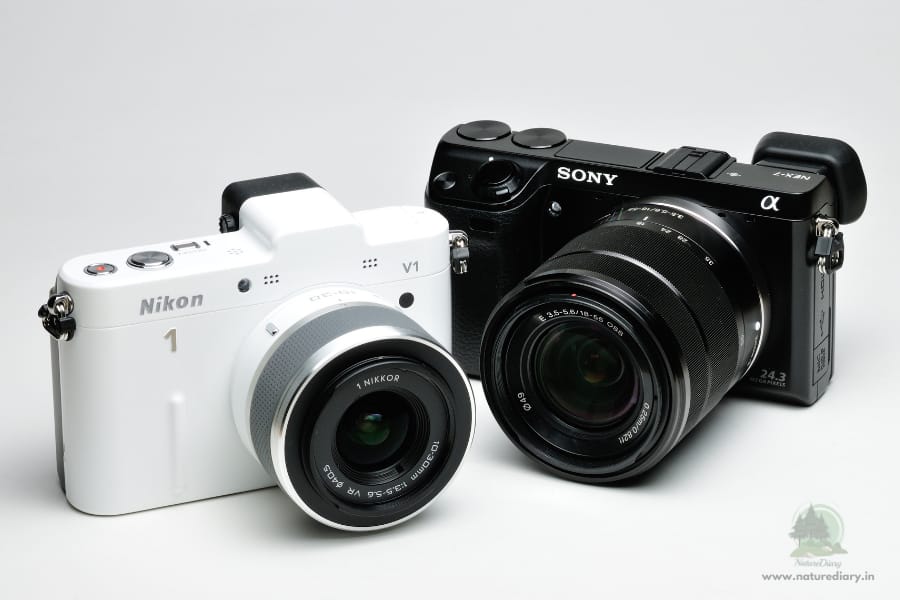Mirrorless cameras were considered a potential threat to DSLR cameras when they first entered the market. However, with each passing year and rapidly evolving technology, both mirrorless and DSLR cameras have undergone various improvements, and picking a clear winner between them is more challenging than ever.
With that said, let’s look at various aspects of Mirrorless vs. DSLR Cameras and settle this never-ending debate once and for all. One thing is for sure, though, both of these cameras possess several distinct features that serve user bases with different interests, needs, and demands.

Mirrorless vs. DSLR Camera Comparison
| Point of Difference | Mirrorless Camera | DSLR Camera |
|---|---|---|
| Size and Weight | Mirrorless cameras and smaller and more compact. While some photographers consider it as an advantage, it’s a drawback for other photographers. | DSLRs are bulkier cameras and weigh more due to the inbuilt mirror and optical viewfinder. |
| Viewfinder and Image Preview | Mirrorless cameras utilize an electronic viewfinder to preview the image- the clarity and accuracy of which are questionable in many cases. | DSLRs come with an optical viewfinder that shows you the exact image the camera will capture. |
| Autofocus System | The autofocus capabilities of a modern mirrorless camera outpace that of a DSLR. | Although this wasn’t always the case, the autofocus capabilities of DSLRs aren’t that great. |
| Image Quality | Mirrorless cameras generally have a smaller image sensor, due to which the image quality suffers. | Even some entry-level DSLRs can produce true-to-life images due to a bigger sensor. |
| Image Stabilization | Some expensive and premium mirrorless cameras offer better stabilization than DSLRs. | DSLRs have less-effective image stabilization in case of a more significant movement. |
| Video Quality | With superior autofocus and tracking capabilities, the video quality of mirrorless cameras is second to none. | DSLRs can capture videos, but they fall short of the cinema-grade quality that mirrorless cameras can provide. |
| Lenses and Accessories | Mirrorless cameras have a far narrower selection of lenses and accessories. You only have access to brand-manufactured accessories that are limited and mostly unreliable. | These cameras can be equipped with various third-party lenses, making them suitable for every scene. |
| Continuous Shooting Time | Mirrorless cameras can shoot at higher frames. They don’t have a physical mechanism that enables them to take burst shots at >20 frames per second. | DSLR cameras are pretty restricted due to the physical mirror and shutter mechanism. |
| Battery Life | The battery life of mirrorless cameras isn’t that great and will struggle to last a full day. | Although this is changing, DSLRs are far more efficient, resulting in better battery life. |
| Durability | Mirrorless cameras are durable. | DSLRs come with a sturdy body and are far more durable than mirrorless cameras. |
| Ease of Use | These cameras are beginner-friendly and easy to use. | The controls of all DSLR cameras aren’t beginner-friendly. |
| Price Range | ₹47000 to ₹500000 | ₹24000 to ₹550000 |
Read: Best DSLR and Mirrorless Camera for Photography
Mirrorless Camera
As the name suggests, a mirrorless camera works without a reflex mirror. Light passes through the lens and is directly collected by the digital sensor which then displays the image on an LCD screen. This function lets you preview the images before you shoot them, which puts mirrorless cameras on par with DSLRs.

Advantages of Mirrorless Camera
The autofocus functionality in mirrorless cameras is second to none, and no professional photographer denies that fact. You can place the autofocus point wherever you like in the viewfinder with mirrorless cameras. The same can be done in DSLR cameras, but the autofocus would go haywire if there’s any unexpected movement. Mirrorless cameras compensate very effectively in such scenarios.
One of the most significant advantages of having a mirrorless camera is its tracking capabilities. In tracking mode, you can select any subject in the viewfinder, and the autofocus area or the AF area will chase the subject as it moves. While brands like Nikon are trying to implement this technique in their DSLR cameras, its efficiency is far inferior to that of mirrorless cameras.
Through years of evolution, mirrorless cameras have effectively surpassed their DSLR cousins in the video recording department. Better autofocus, better tracking, and faster frame rates make mirrorless cameras ideal for recording videos.
Unlike most DSLRs, mirrorless cameras have a silent shutter which makes them super handy around sensitive subjects (e.g., kids).
Disadvantages of Mirrorless Camera
Unlike DSLRs that are ready to use the moment you turn them on, mirrorless cameras take a while to start up and take even more time to come out of standby mode.
Compared to DSLR, mirrorless cameras are pretty expensive, making them inaccessible to non-professional users.
Cross-type autofocus always helps with professional photography, which mirrorless cameras lack. DSLR cameras, in this case, are far more effective.
Best Uses of Mirrorless Cameras
The video recording capability of mirrorless cameras is far superior to that of DSLRs. Newer and more expensive cameras have advanced autofocus and tracking capabilities, enabling them to capture cinematic videos.
Mirrorless cameras come with EVF (Electronic Viewfinder), enabling people with impaired vision to use the camera without glasses. That said, as long as the diopter can adjust to your vision, you’re good to go.
DSLR Camera
DSLR camera stands for Digital Single Lens Reflex camera, which efficiently uses the combination of a single-lens reflex camera and a digital imaging sensor to capture images. In this design, light travels through the lens and strikes a mirror that redirects the light to a prism. This prism then shows the image in the viewfinder. DSLRs are currently one of the most popular photography cameras out there, thanks to their tremendous benefits.

Advantages of DSLR Camera
The battery life of even some entry-level DSLR cameras like Canon 1500D far exceeds that of expensive mirrorless cameras. That’s because, unlike mirrorless cameras, DSLR cameras do not need a power-hungry electronic viewfinder to display the image. Instead, they have an optical through-the-lens (TTL) viewfinder.
Unlike mirrorless cameras, DSLRs take no time to start up. Just flip them on, and they’re ready to capture unique shots.
Owning a DSLR camera means having access to a plethora of lenses for different purposes. This is an area where mirrorless cameras significantly lag.
Most professional photographers prefer a customizable camera to feel the true essence of professional photography. DSLR cameras are heavy and look very appealing, unlike small and light mirrorless cameras that do not usually provide the actual photography experience.
The optical viewfinder in DSLRs helps the user with a fantastic photography adventure. For instance, since the image is displayed directly through the lens and not through an electronic viewfinder, the captured images don’t differ from the viewfinder’s images. The same can’t be said for mirrorless cameras.
DSLRs are resilient and are built to withstand rough and heavy usage under harsh conditions. The lenses and multiple other elements of DSLRs also have more protection from outside factors like dust, sunlight, and water splashes.
Disadvantages of DSLR Camera
DSLR cameras have a mechanical shutter that comes up and down whenever shots are taken. This produces a noise level while capturing shots which can be problematic for sensitive subjects. While some modern DSLRs are coming with a silent shutter mode, it’s nearly not as effective as a mirrorless camera.
The modern and technically advanced mirror and shutter mechanism look impressive on paper, but it’s limited by the speed the mirror has to flip up and down. For example, the Nikon D4 DSLR can fire shots at 11 frames per second, translating to the mirror flipping 11 times in one second.
A DSLR camera’s mirror and shutter mechanism aren’t easy to repair and take time, even for the highest-rated authorized service centres. This makes repairing a DSLR significantly expensive as compared to a mirrorless camera.
Best Uses of DSLR Cameras
DSLRs are known for capturing the best quality images for different types of photography. It is also good for that gorgeous bokeh effect in portraits. This improves the depth of the image significantly.
The batteries inside a DSLR camera packs a lot of power, way more than what mirrorless cameras have to offer. This makes these cameras a piece of must-have equipment at trekking destinations and camping places.
Frequently Asked Questions (FAQ)
Size and weight are important factors to consider, especially if you’re a professional photographer. In that case, mirrorless cameras have the advantage. Mirrorless cameras are compact and weigh much less than DSLR cameras, making them highly portable. DSLRs, on the other hand, thanks to their complex design with mirror and shutter mechanism, are big and clunky. However, some photographers prefer DSLRs solely due to their sturdy feel and weight.
The viewfinder is where the image preview is displayed before you press the shoot button. Mirrorless cameras utilize a power-hungry electronic viewfinder that translates to bad battery life and inaccurate images, i.e., the captured images can significantly differ from the ones that the electronic viewfinder displays. In this area, DSLRs outpace mirrorless cameras as they use an optical TTL viewfinder that displays the exact image that the camera will capture.
The autofocus system comes in handy for busy backgrounds and moving subjects. The ability to compensate for sudden and unexpected movement with autofocus to maintain superior quality consistently is crucial for any professional camera. In that case, mirrorless cameras are beneficial. That said, the autofocus system of mirrorless cameras is very effective compared to even the most top-rated DSLRs. That’s because mirrorless cameras utilize both phase detection and contrast-detection to separate the subject from the background. In contrast, most DSLRs only use phase-detection sensors for autofocus.
Image quality is probably the most crucial factor to consider when choosing a camera. The size of the image sensor mainly helps in capturing the most pleasing shots with as much detail as possible. This becomes especially helpful in low lighting or artificial lighting conditions. Most DSLRs come with larger image sensors that help these cameras capture outstanding shots with a bokeh effect on close subjects. While modern mirrorless cameras boast comparatively larger image sensors, they’re incredibly pricey, which is also a considerable demerit of mirrorless cameras.
It’s not always possible to stay rock-steady while capturing shots. Image stabilization comes in handy in such cases. Both mirrorless and DSLR cameras use optical image stabilization to counter minimal shakes. Some expensive models of mirrorless cameras use in-body 5-axis image stabilization, which is very effective compared to other methods that most DSLRs use. However, when it comes to entry-level cameras, both DSLR and mirrorless cameras share the same image stabilization techniques.
While DSLRs do better than mirrorless cameras in image quality, they fail to maintain that quality in videos where live preview is required at all times. That’s because, with the mirror up, DSLRs can’t use phase detection and have to rely on the contrast-detection focus method, which is less accurate and slower. On the other hand, Mirrorless cameras work wonders when it comes to recording videos.
A professional photographer likes to carry different lenses and accessories to get the best shots of every scene. While DSLRs can be equipped with many lenses and accessories, mirrorless cameras are restricted and do not offer many customization options. The owner of a mirrorless camera has to rely on the brand for lenses and accessories, which is very limited in most cases.
In this mode, the camera captures several images per second. In that case, mirrorless cameras leave DSLRs in the dust since they rely on the digital sensor to take burst shots. On the other hand, DSLR cameras utilize a physical mirror and shutter mechanism that moves up and down every time a shot is taken. This limits DSLRs from taking a more significant number of continuous burst shots.
The area where DSLRs have consistently managed to outpace mirrorless cameras is in the battery department. Mirrorless cameras have no optical viewfinder and thus have to rely on laggy and power-hungry electronic viewfinders (EVF). On the other hand, DSLRs use an optical viewfinder that consumes very little battery compared to EVF. Although modern mirrorless cameras have improved dramatically in the battery department compared to their predecessors, they still lag far behind DSLRs.
The durability of a camera accounts for its safety under rough conditions. In that case, as if the looks of these cameras don’t give it away, DSLRs are very strong and have a sturdy build. They also have better protection from external elements, unlike mirrorless cameras that use lighter materials and have far inferior build quality. However, this makes mirrorless cameras lightweight, which may be a pro for a fraction of photographers.
When it comes to ease of use, mirrorless cameras come with a straightforward design and less-cluttered controls, making them beginner-friendly. DSLR cameras, however, are more inclined towards professional photography and come with a plethora of options to have total control. While complex controls make DSLRs suitable for professional use, they’re nowhere as beginner-friendly as mirror cameras.
In general, both DSLRs and mirrorless cameras fall in the same range. However, entry-level mirrorless cameras are straight-up bad and come nowhere close to DSLRs with a similar price tag in terms of value for money. So, mirrorless cameras are generally classified as pricey compared to most DSLRs.

So, Mirrorless camera or DSLR camera – Which is better?
Hopefully, this thorough discussion on Mirrorless vs. DSLR will help you choose the right camera for you. Both types of cameras have their own sets of pros and cons, and neither can be said universally best or universally worst.
So, in the end, everything boils down to one’s needs and requirements. While mirrorless cameras work perfectly when recording videos with moving subjects and busy backgrounds, DSLRs are more suitable for capturing images and are comparatively unreliable for recording videos.
So, if you use your camera primarily for video recording and do not mind the short battery life, mirrorless cameras are the way to. But, if you’re a traveller and your primary aim is to capture portraits and scenes in different environments, buying a good quality DSLR is the ideal choice for you.
Other Types of Cameras: